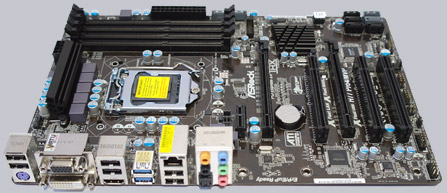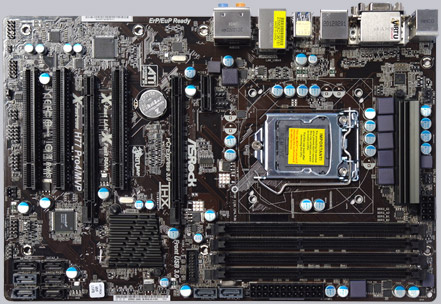
Result and general impression
++ The ASRock H77 Pro4 MVP/A/ASR motherboard has a price of approx. 80 Euro (06/2012) and is thus in the lower price segment of the Intel LGA 1155 Ivy Bridge motherboards.
Who like to buy a current Ivy Bridge LGA 1155 CPU or would like to acquire a new motherboard for an existing Sandy Bridge CPU can select between some new chipsets like e.g. the Intel Z77, H77 and Q77 chipset. Today we have chosen a more inexpensive ASRock H77 Pro 4/MVP Intel LGA1155 board with H77 chipset for review. The layout and the basic equipment of the ASRock Z77 Pro4 is nearly identical with the approx. 30 Euros cheaper ASRock H77 Pro 4/MVP motherboard, we test today at ocinside.de. However, there are very clear differences between the H77 vs Z77 motherboard that become important especially when overclocking. Overclockers should read the details inside of this review before they purchase a H77 motherboard.
The ASRock H77 Pro4/MVP LGA1155 motherboard is delivered in this cardboard box:
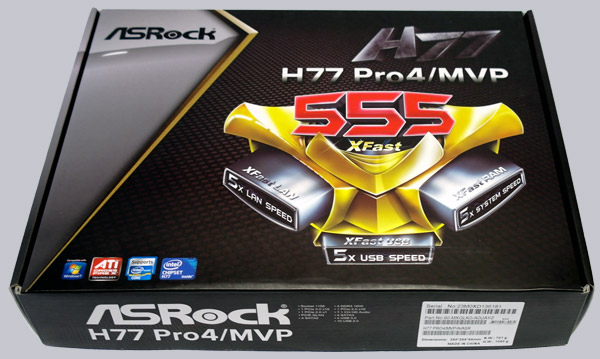
The ASRock H77 Pro4 MVP board is build with high-quality Solid Caps capacitors and makes a very good impression of the layout as well as the processing. In order to reach the user or system builder still in perfect condition, it was carefully wrapped with foam:
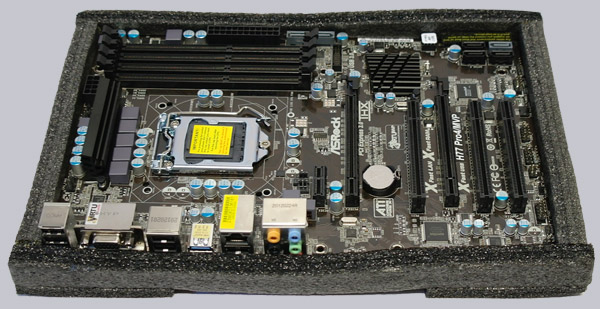
You should pay attention to the label before removing, because you get the fastest SATA connection over the H77 chipset, which is available only through the SATA3 ports 0-5 and not over the other two SATA3 ports of the additional ASMedia ASM1061 chip:
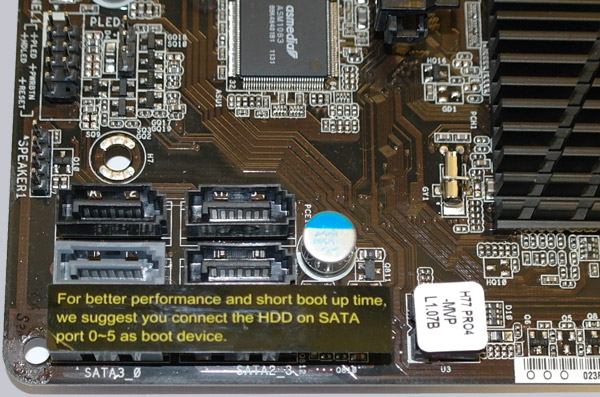
Here you can see the Intel E206A729 H77 chipset under the heatsink:
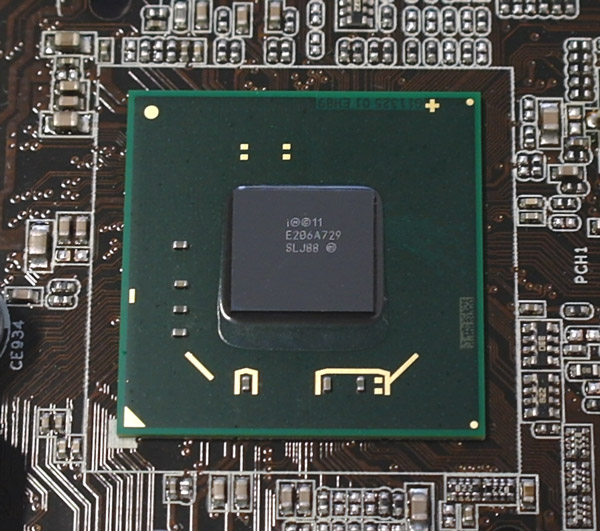
At least when one detach the label of the ASRock H77 Pro 4/MVP, it becomes clear that the board is except the chipset almost identical to the ASRock Z77 Pro 4 motherboard:
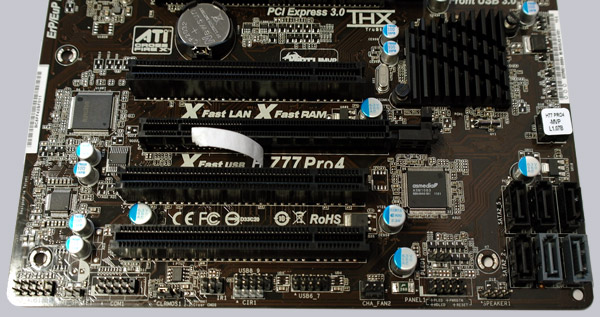
Equipment and other features …
The ASRock H77 Pro4 MVP motherboard came with a manual, the above mentioned software setup guide, one DVD, two SATA data cables and one ATX I/O shield. USB Slot brackets or the ASRock 3.5-inch USB3.0 frontpanel are not included.
Expansion cards …
The motherboard offers one PCI Express 3.0 graphics card slot for Intel Ivy bridge processors, which can be used also for PCI Express 2.0 graphics card with x16 lanes with Intel Sandy Bridge processors and one additional PCI Express 2.0 x16 slot for CrossFireX. In addition, there are three PCI slots and one x1 PCIe 2.0 slot.
Memory …
The ASRock H77 Pro4 MVP can be equipped with up to four DDR3 modules and is expandable depending upon operating system used (see list) to maximally 32 GB memory.
The Intel LGA 1155 motherboard supports DDR3 memory modules and can be optimized in the BIOS for DDR3-1066 or DDR3-1333 with an Sandy Bridge processor and DDR3-1066, DDR3-1333 or DDR3-1600 Dual Channel modules with an Ivy Bridge processor. Higher RAM clock-rates are currently not possible with the H77 chipset contrary to its Z77 variant !
Hard disk drive connectors …
The ASRock H77 Pro4 MVP offers no floppy connector or PATA connector for conventional IDE drives, but it offers by the ASMedia Chip two SATA3 ports and by the Intel H77 chipset two SATA3 connectors (6 Gb/s) and four additional SATA2 connectors (3 Gb/s). The S-ATA3 ports supports RAID 0, RAID 1, RAID 10, RAID5, Intel Rapid Storage Technology – RST, Intel Smart Response Technology, NCQ, AHCI and the Hot Plug function in AHCI mode (AHCI stands for Advanced Host Controller Interface).
The manual and the included DVD contains all basic information to manage a new installation of Windows XP, Windows Vista or Windows 7 with S-ATA3 hard disk drives, and how to make a RAID installation. 32-Bit and 64-Bit drivers for Windows 7, Windows Vista and Windows XP are provided on the DVD and can be downloaded on the ASRock support page. The UEFI BIOS support drives with more than 2TB for Windows 7 x64 or Vista x64 installations.
USB and Firewire …
The board has two USB 3.0 connectors at the ATX-panel, six USB 2.0 connectors at the ATX panel, two internal USB 2.0 plugs for up to four optional USB ports and three internal USB 3.0 plugs for up to two optional USB ports.
Hint: One should install the new ASRock XFast USB software to accelerate the USB transfer rate e.g. for USB sticks clearly. Who uses Windows 7, should also install the ASRock XFast RAM software, which we have discussed already several times in some forum posts. There you will find a few interesting benchmarks (e.g. here from cheech2711) and for further questions our forum is available 24 hours a day.
Network …
The ASRock H77 Pro4 MVP motherboard is provided with the Realtek RTL 8111E chip which offers a 10/100/1000 network connector on the I/O panel. The LAN connection is WoL capable, offers LAN cable detection and supports energy efficient 802.3az ethernet.
Hint: For the LAN connection one should install the new ASRock XFast LAN software, to speed up the network access by means of prioritisation.
Serial and parallel port …
This motherboard does not provide a parallel port. The serial port is optionally available as internal onboard connector.
Sound …
The ASRock H77 Pro4 MVP motherboard is equipped with the ALC892 audio codec with content protection, which supports 7.1 surround sound for example analog over 5x 3.5mm connectors on the ATX panel or over an internal frontpanel audio connector. Another special feature is the new ASRock On/Off Play Technology, which offers an option in the BIOS to enable or disable the output of external audio signals also when the PC is powered off.
For the digital output there is an internal HDMI SPDIF out connector available, to connect it for example with a SPDIF cable to a HDMI suited video card, in order to get the digital audio and video signal to a HDMI equipment like a HD-Ready LCD TV. Additionally there is also an optical digital SPDIF output, THX TruStudio support and premium Blu-Ray audio support. So most users don’t need to buy an additional sound card with digital outputs.
Graphics …
The new Intel H77 chipset offers in combination with an Intel Ivy Bridge processor a full integrated Graphics Technology (GT) graphics solution with DX10.1 support and in combination with an Intel Ivy Bridge processor the iGPU supports DirectX 11. Depending upon processor used there is an Intel HD Graphics 2000/3000/2500/4000 graphics unit, whereby the Intel Core i5-2500K CPU used in this test is equipped with the HD Graphics 2000.
The performance of the Intel iGPU is already without overclocking really good. So the Intel HD Graphics Unit of the Intel Core i5-2500K CPU achieved in Windows 7 with 3DMark06 a benchmark score of 4310 3DMarks. An AMD HD 4290 IGP of an AMD 890GX chipset achieved with an AMD Phenom II 710 X3 processor for example a score of 2204 points in 3DMark06 (tested with an ASRock 890GX Extreme4). Furthermore the integrated video processor supports DirectX 10.1/11, HDCP, Full HD 1080p and offers thanks to its onBoard HDMI connector also optimal conditions for a Home theatre PC.
With Lucid Virtu Universal MVP it is possible to run a combination of the internal graphics unit of the LGA1155 processor and a PCI Express video card, in order to lower the current consumption and increase the performance clearly in some applications.
ATX backpanel connectors …
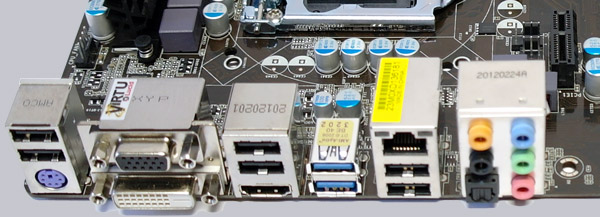
From left to right one can see 2x USB 2.0 ports, the PS/2 connector for a PS/2 keyboard, 15-pol Sub-D VGA and DVI-D VGA, 2x USB 2.0 and HDMI, 2x USB 3.0, RJ45 Gigabit LAN and 2x USB 2.0 ports, optical SPDIF out and 5x 3.5mm jacks for analog sound.
BIOS and Overclocking …
Let us continue with BIOS options and BIOS overclocking. By pressing F2 or Del, you get access to the AMI BIOS with all important hardware settings.
ASRock replaced the conventional BIOS on all newer motherboards with the UEFI (Unified Extensible Firmware Interface) Setup. New above all is the graphical surface of the UEFI BIOS, which permits an operation with the mouse, but although depending upon desire it can be controlled also only with a keyboard.
Hint: USB mouse and USB keyboard user should not deactivate the Legacy USB support in the BIOS with the USB Configuration, because otherwise they can’t access the UEFI Setup.
Here the ASRock H77 Pro4/MVP bootscreen with the well-known ASRock 555 XFast options:
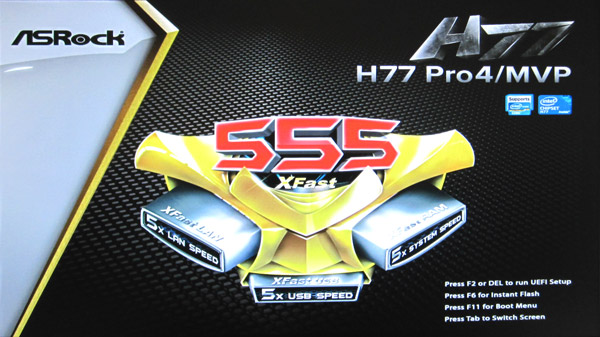
Here you can see the graphical UEFI BIOS interface, which is again expanded:
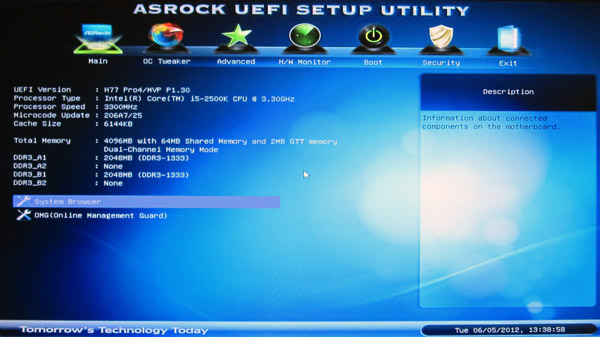
With the new system browser you get a quick overview of the installed hardware:
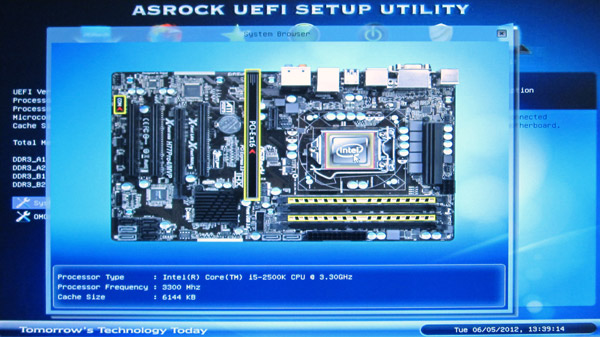
ASRock offers several ways to update the BIOS and one comfortable option to flash BIOS updates is the so-called ASRock Instant Flash option. One can get into the ASRock Instant Flash utility in the Advanced BIOS or by pressing F6 during the PC start. Hereby one can very easy upgrade a downloaded ASRock BIOS without further boot CD, USB boot stick, etc. Just start the ASRock Instant Flash utility and select a BIOS Flash ROM from any FAT formatted device like an USB Stick to flash the BIOS without an additional boot medium. If you store the BIOS file in the main path of an USB 2.0 stick, even the new ASUS Crashless BIOS is supported, which continues an update even after a power failure. At review date, the latest UEFI BIOS version was P1.30, which we updated of course with the comfortable Instant Flash Tool.
How to overclock the motherboard …
The BIOS of the H77 offers unfortunately very few DDR3 memory settings like e.g. the memory frequency setting from DDR3-1066 to DDR3-1333 and with an installed Intel Ivy Bridge CPU up to DDR3-1600. OC-settings like DDR3-1866 and DDR3-2133 are not available like you can see on this screenshot:

For CPU overclocking the H77 chipset offers also only very few settings. ASRock offers a clearly arranged OC-Tweaker menu in the UEFI Setup, but the BCLK host clock is not adjustable.
And also the multiplier of an Intel Core i5-2500K CPU could not be increased. Who bought an Intel “K” CPU, has usually an unlocked multi and can increase the CPU multiplier to reach the desired CPU frequency, but not with this H77 Pro4/MVP motherboard. The H77 motherboard offers only the maximum Turbo multi, which is predefined as in a non “K” CPU. So it was only possible to overclock it up to the maximum Turbo clock, what is of course by no means acceptable for a buyer of a “K” CPU.
So with the H77 board and the Intel Core i5-2500K Sandy Bridge CPU is wether a BCLK nor a multiplier setting available, so one can save in this case the money for the more expensive “K” variant at a H77 motherboard or have to spend more money for the Z77 chipset.
In spite of the missing OC, this board offers a Vcore setting on the Intel Core i5-2500K Test CPU between -0.300 and +0.600V, an iGPU voltage between -0.300 and +0.600 Volt, PCH Chipset voltage between 0.780 and 1.646 Volt, VTT voltage between 0.768 and 1.634 Volt, VCCSA System Agent Voltage between 0.925 and 1.200 Volt, CPU PLL Overvoltage 1.586 to 2.349 Volt and a lot of more voltage settings. The DDR3 memory voltage can be adjust between 1.165 Volt up to 1.800 Volt.
Nevertheless is the ASRock AXTU software helpful to control the fans, monitor the temperature, enable the XFast RAM setting or adjust the overclocking settings of the iGPU or set the voltage and Turbo ratio of the CPU:
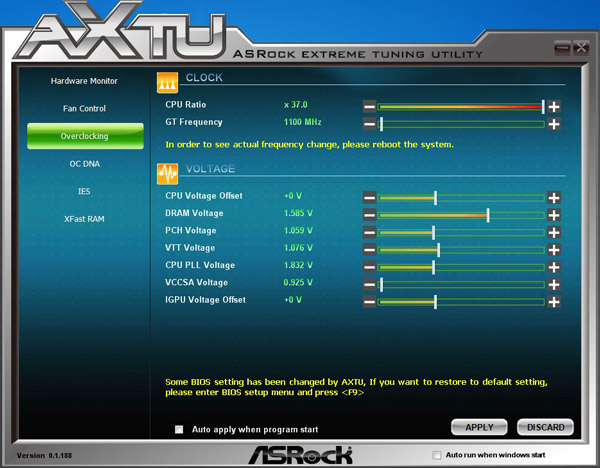
As special feature one can store different BIOS settings in the BIOS or in the AXTU Tool with a desired name to load them very quickly at any time. It is not as important without usual overclocking settings, but one can save for example extreme power saving BIOS settings.
BIOS Undervolting …
The downclocking or underclocking was also tested in this review. It was possible to lower the Intel Core i5-2500K CPU multiplier over the BIOS to 16x and the processor can be underclocked in such a way with 100 MHz BCLK to approx. 1600 MHz. Underclocking is like OverClocking outside of the manufacturers specification, so it is necessary to have a bit luck and ASRock gives several options for easy PC underclocking / downclocking.
The BIOS and the ASRock Extreme Tuning Utility of the passive cooled H77 Pro4 MVP motherboard offers a CPU Quiet Fan option (temperature fan control) for a 4-pin CPU fan, a 3-pin CPU fan and a 4-pin chassis fan. Also the other chassis fans can be adjusted manually, so it is not necessarily to buy an additional fan controller.
Power consumption …
Power consumption will vary depending upon the hardware and upon the PC load. The current consumption of the test PC with Intel Core i5-2500K CPU, 4GB DDR3-1333 memory, hard disk drive and Cooler Master Silent Pro M 600W test PSU was without overclocking depending upon load: – With Sapphire HD4870 video card the power consumption was between 115W idle and 225W max. – With Sapphire HD6870 video card the power consumption was between 25-72W idle and 187W max. – With onBoard Intel HD Graphics 2000 GPU the power consumption was between very low 16 Watt idle and 96 Watt with full load. Thus, above all the idle power consumption and the maximum power consumption with full load is very low with the integrated GPU and thanks to Lucid Virtu it is possible to combine the integrated graphics unit of a Sandy Bridge or Ivy Bridge processor with a PCI Express video card, in order to reduce the power consumption of specific applications at high graphics performance.
Result …
The ASRock H77 Pro4 MVP LGA1155 DDR3 motherboard is with the Intel H77 chipset a reasonably priced high-quality platform for current Ivy Bridge or Sandy Bridge LGA1155 processors, offers Lucid Virtu Universal MVP, but offers only a few overclocking settings.
The basic equipment of this H77 Pro 4 MVP motherboard offers four SATA3 ports, four additional SATA2 ports, up to four possible USB 3.0 ports, up to ten possible USB 2.0 ports, Gigabit LAN, 7.1 sound with ON/Off Play Technology, analog sound output over five connectors, digital sound output over an optical or HDMI SPDIF connector and graphics output with a Sandy Bridge or Ivy Bridge processor by a VGA, HDMI or DVI-D connector. Additional eSATA3 ports, IEEE1394 firewire ports or the USB 3.0 front panel is not available on this ASRock motherboard, because not every user need these interfaces.
All in all the ASRock H77 Pro4/MVP is a very inexpensive solution with Intel H77 chipset and offers thanks to the Lucid Virtu Universal MVP technology a low power consumption. Contrary to the ASRock Z77 Pro4, there is currently no way to overclock the BCLK base clock or the multiplier of a Sandy Bridge “K” CPU outside the turbo rate with this Pro4/MVP H77, so the extensive voltage settings of this ASRock H77 Pro motherboard seems only useful for CPU underclocking. Overclocker should definitely spend the extra charge to the Z77 motherboard.
Here you can buy the ASRock H77 Pro4 MVP motherboard. *Ad
Special thanks to ASRock for their support.
* All LGA 1155 motherboard reviews since 01.07.2011 are based on an Intel Core i5-2500K CPU, 1x Sapphire HD6870 1024MB ATI Radeon HD6870 PCI Express 2.0 video card, 1x Sapphire HD4870 512MB ATI Radeon HD4870 PCI Express 2.0 video card, 2x 2048MB Crucial Ballistix Tracer DDR3-1333/PC3-10600 memory modules, Cooler Master Silent Pro M 600W power supply unit and the following software configuration: Microsoft Windows 7 Ultimate, Microsoft Windows Vista Ultimate, SiSoftware Sandra 2011, Futuremark 3DMark11, 3DMark Vantage, 3DMark06 and 3DMark03 (the software is available in the Links & Downloads section). All benchmark results only offer a comparison among themselves for a rough motherboard performance comparison.
Back to the motherboard comparison with all AMD and Intel motherboard reviews !


